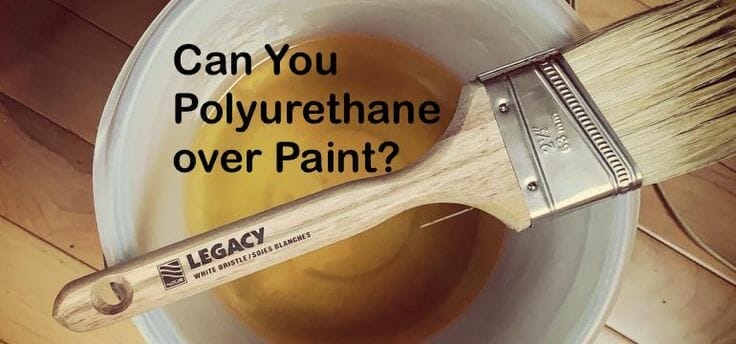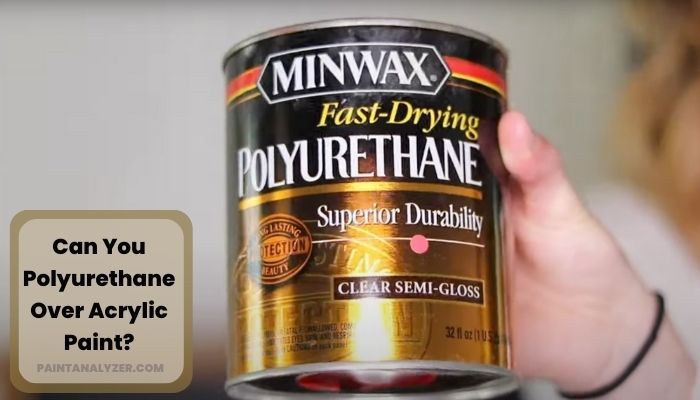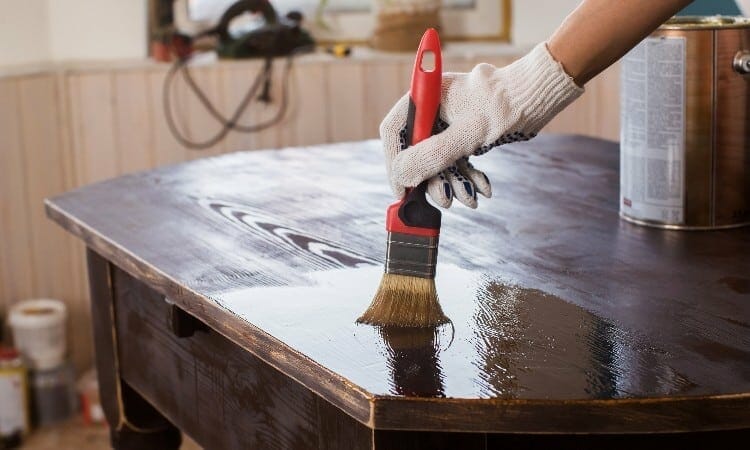Yes, you can use polyurethane over acrylic paint. Applying a polyurethane topcoat can provide an extra layer of protection to your acrylic painted surfaces, making them more durable and resistant to wear and tear.
Polyurethane is a clear, glossy finish that can enhance the appearance of your acrylic paint and also protect it from moisture, UV rays, and scratches. It can be applied using a brush, roller, or spray, depending on your preference and the size of the project.
Before applying polyurethane, make sure your acrylic paint is fully dry and cured. Sanding the surface lightly can help promote adhesion between the paint and the polyurethane. Additionally, ensure proper ventilation during application and allow sufficient drying time for the polyurethane to fully cure.
Overall, using polyurethane over acrylic paint is a great way to increase its longevity and maintain its vibrant look for a longer period.

Achieving a Smooth Finish: Applying Polyurethane over Acrylic Paint
When it comes to protecting and enhancing the appearance of your painted surfaces, applying a topcoat is essential. Polyurethane is a popular choice for this purpose, as it provides a durable and glossy finish. If you have acrylic paint on your surface and want to achieve a smooth and professional-looking result, applying polyurethane over it is a great solution. In this section, we will guide you through the process of applying polyurethane over acrylic paint to achieve a flawless finish.
Materials You Will Need:
Before you begin, gather the following materials:
- Acrylic paint
- Polyurethane
- Paintbrush or foam brush
- Sandpaper (fine grit)
- Clean cloth
- Tack cloth
- Paint tray
- Protective gloves
- Drop cloth or newspaper
- Optional: paint sprayer
Step-by-Step Guide:
1. Prepare the Surface:
Ensure that the surface you want to apply polyurethane on is clean and dry. If necessary, remove any existing dirt, debris, or loose paint using a mild detergent and water. Rinse the surface thoroughly and allow it to dry completely before proceeding.
2. Test Compatibility:
It is crucial to check the compatibility between the acrylic paint and the polyurethane before proceeding with the application. To do this, apply a small amount of polyurethane to a discreet area and observe for any adverse reaction. If the polyurethane causes the acrylic paint to bubble, peel, or react negatively, it is not suitable for your project.
3. Sand the Acrylic Paint:
To ensure proper adhesion of the polyurethane, lightly sand the surface of the acrylic paint using fine-grit sandpaper. This will help create a rougher surface for the polyurethane to grip onto. After sanding, wipe away any dust with a clean cloth.
4. Apply the First Coat:
Pour a small amount of polyurethane into a paint tray. Using a paintbrush or foam brush, apply a thin and even coat of polyurethane over the sanded acrylic paint. Be sure to follow the manufacturer’s instructions regarding drying times and application techniques. Allow the first coat to dry completely before proceeding to the next step.
5. Sand and Remove Dust:
After the first coat of polyurethane has dried, lightly sand the surface again using fine-grit sandpaper. This step will help smooth out any imperfections or brush strokes. Once sanding is complete, wipe away any dust with a tack cloth or a clean, lint-free cloth.
6. Apply Subsequent Coats:
Repeat the process of applying thin and even coats of polyurethane, allowing each coat to dry completely before applying the next one. The number of coats you apply will depend on the level of protection and the desired finish. Typically, two to three coats are sufficient for a smooth and glossy appearance.
7. Optional: Use a Paint Sprayer:
If you prefer a more uniform and professional finish, you can use a paint sprayer instead of a brush. Follow the manufacturer’s instructions for proper setup and application techniques. Using a paint sprayer can help minimize brush strokes and create a smoother overall finish.
Summary:
By following these steps and using the right materials, you can achieve a smooth finish by applying polyurethane over acrylic paint. Remember to prepare the surface properly, test compatibility, sand the acrylic paint, apply thin coats, and sand between each coat for optimal results. Whether you choose to use a brush or a paint sprayer, the key is to ensure even application and allow sufficient drying time between coats. With a little patience and attention to detail, you can protect and enhance your acrylic paint with a flawless polyurethane finish.

Long-lasting Preservation: Benefits of Sealing Acrylic Paint with Polyurethane
When it comes to acrylic paint, artists and DIY enthusiasts alike appreciate its versatility, vibrant colors, and quick-drying properties. However, to ensure the longevity and preservation of acrylic paintings, it is crucial to seal them with a protective layer. One popular choice for sealing acrylic paint is polyurethane. In this section, we will explore the benefits of using polyurethane as a sealant for acrylic paint.
1. Protection against Environmental Factors
Polyurethane provides a durable and protective barrier that shields acrylic paint from various environmental factors that can cause damage over time. This includes protection against UV rays, moisture, dust, and dirt. UV rays, in particular, can cause acrylic paint to fade or become discolored. By sealing the paint with polyurethane, you can prevent these issues and ensure that your artwork maintains its vibrant colors for years to come.
2. Enhanced Durability
Acrylic paint on its own can be prone to chipping, cracking, or peeling, especially if the surface is subject to frequent handling or exposure to the elements. However, by applying a layer of polyurethane, you can significantly increase the durability of the paint. Polyurethane forms a tough and protective coating that helps to prevent damage caused by everyday wear and tear, ensuring that your artwork remains intact and looking its best.
3. Improved Resistance to Moisture
Moisture can be particularly detrimental to acrylic paint, as it can lead to warping, mold, or other forms of degradation. Polyurethane acts as a barrier against moisture, preventing it from seeping into the paint and causing damage. This is especially important if your artwork will be displayed in areas with high humidity levels or if it will be exposed to moisture, such as in bathrooms or kitchens. By sealing acrylic paint with polyurethane, you can safeguard it against the harmful effects of moisture and ensure its long-term preservation.
4. Easy to Apply
One of the advantages of using polyurethane as a sealant for acrylic paint is its ease of application. Polyurethane is available in various forms, including spray, brush-on, and wipe-on options. This versatility allows you to choose the most convenient method based on your preferences and the size of your artwork. Additionally, polyurethane dries relatively quickly, which means you can complete the sealing process efficiently and without extended waiting times.
5. Enhances the Appearance
Sealing acrylic paint with polyurethane not only protects the artwork but also enhances its overall appearance. Polyurethane creates a glossy or satin finish, depending on the desired effect, which can add depth and richness to the colors of the paint. This glossiness can make the artwork look more professional and polished, giving it a finished and refined look. Additionally, polyurethane eliminates the uneven sheen that can occur when different areas of the painting have different levels of paint thickness, providing a more uniform and visually appealing finish.
6. Long-lasting Results
By sealing acrylic paint with polyurethane, you are investing in the long-lasting preservation of your artwork. Polyurethane provides a protective layer that can withstand the test of time. Unlike other sealants that may deteriorate or yellow over time, polyurethane maintains its effectiveness and clarity, ensuring that your acrylic paintings stay vibrant and protected for years to come.
In summary, sealing acrylic paint with polyurethane offers numerous benefits for the long-lasting preservation of artwork. From protection against environmental factors and enhanced durability to improved resistance to moisture and an enhanced appearance, polyurethane is a reliable and effective sealant choice. By sealing your acrylic paintings with polyurethane, you can ensure that they remain vibrant, protected, and visually appealing for years to come.

Extending the Lifespan: How Polyurethane Can Keep Acrylic Paint Looking Fresh
Acrylic paint is a popular choice among artists and hobbyists due to its versatility and vibrant colors. However, over time, acrylic paint can fade, crack, or become dull, compromising the beauty of the artwork. To prevent these issues and extend the lifespan of acrylic paint, many artists turn to polyurethane.
Polyurethane is a clear protective finish that can be applied over acrylic paint to provide a durable and long-lasting coating. It acts as a barrier, protecting the paint from external factors that could cause damage or deterioration.
Why Use Polyurethane on Acrylic Paint?
There are several reasons why artists choose to use polyurethane on their acrylic paintings:
- Protection: Polyurethane forms a protective layer over the paint, shielding it from harmful elements such as UV rays, moisture, and dust. This helps to prevent fading, yellowing, and other forms of deterioration.
- Durability: Polyurethane creates a strong and durable finish that can withstand normal wear and tear. It adds a layer of strength to the paint, making it less prone to chipping, cracking, or peeling.
- Enhanced Visual Appeal: Applying polyurethane can enhance the vibrancy of the colors in the acrylic paint, giving them a glossy or satin finish. This adds depth and richness to the artwork, making it more visually appealing.
- Easy Maintenance: Polyurethane provides a smooth and easy-to-clean surface, making it easier to remove dirt, dust, or other contaminants without damaging the underlying paint.
- Longevity: By protecting the paint from environmental factors, polyurethane helps to extend the lifespan of acrylic artwork, ensuring that it can be enjoyed for many years to come.
Applying Polyurethane to Acrylic Paint
Before applying polyurethane to acrylic paint, it is important to prepare the surface properly. This involves ensuring that the paint is completely dry and free from any dust or debris. It is recommended to wait at least 48-72 hours after the paint has dried before applying the polyurethane.
When applying polyurethane, there are two main options: spray-on polyurethane and brush-on polyurethane.
Spray-on polyurethane: This option provides a quick and even application, making it ideal for larger surfaces or textured artworks. It is important to apply multiple thin coats, allowing each coat to dry completely before applying the next.
Brush-on polyurethane: This option allows for more control and precision, making it suitable for smaller or detailed artworks. It is recommended to use a high-quality brush and apply thin, even coats. Again, each coat should be allowed to dry before applying the next.
Caring for Acrylic Paint with Polyurethane
Once the polyurethane has been applied, it is important to take proper care of the artwork to maintain its longevity:
- Keep away from direct sunlight: Acrylic paint with polyurethane should be protected from prolonged exposure to direct sunlight, as UV rays can still cause fading over time.
- Handle with care: Avoid touching or scratching the surface of the artwork to prevent any damage to the polyurethane finish.
- Regular cleaning: Dust the artwork regularly using a soft, lint-free cloth or a soft brush to prevent the buildup of dirt or dust.
- Avoid harsh cleaners: When cleaning, avoid using harsh chemicals or abrasive cleaners that could damage the polyurethane coating.
In Summary
Polyurethane is a valuable tool in extending the lifespan of acrylic paint. By providing a protective barrier, it helps to prevent fading, cracking, and other forms of deterioration. With proper application and care, acrylic artwork with polyurethane can maintain its vibrant colors and visual appeal for many years to come.
Enhancing Vibrancy: Using Polyurethane to Amplify Colors in Acrylic Paint
Acrylic paint is a versatile medium that allows artists to express their creativity through vibrant and bold colors. However, sometimes artists may find that the colors in their acrylic paintings appear dull or lack the intensity they desire. In such cases, one effective method to enhance the vibrancy of acrylic paint is by incorporating polyurethane into the painting process.
Polyurethane is a synthetic resin that is commonly used as a protective coating for various surfaces. It is known for its durability, glossiness, and ability to enhance colors. When applied to acrylic paint, polyurethane can help amplify the hues, making them appear more vibrant and intense.
Here are some key benefits of using polyurethane to enhance colors in acrylic paint:
1. Increased Color Saturation
By adding a layer of polyurethane to your acrylic painting, you can significantly increase the color saturation. Polyurethane acts as a magnifying layer, intensifying the pigments in the paint and bringing out their true vibrancy. The result is a more vivid and eye-catching artwork.
2. Improved Light Reflectivity
Polyurethane has excellent light-reflecting properties. When applied to acrylic paint, it creates a glossy finish that enhances the reflection of light off the surface of the artwork. This increased light reflectivity adds depth and dimension to the colors, making them appear brighter and more dynamic.
3. Protection against Fading
Acrylic paint is prone to fading over time due to exposure to sunlight and other environmental factors. By incorporating polyurethane into your painting process, you can provide a protective barrier that helps prevent color fading. Polyurethane acts as a shield, blocking harmful UV rays and preserving the vibrant colors of your artwork for years to come.
4. Enhanced Durability
Polyurethane is renowned for its durability and resistance to wear and tear. When applied to acrylic paint, it forms a strong protective layer that safeguards the colors from scratches, moisture, and other external elements. This added durability ensures that your artwork retains its vibrancy and beauty for an extended period.
5. Versatile Application
Polyurethane can be applied in various ways, allowing artists to experiment and achieve different effects. It can be brushed on, sprayed, or even poured over the acrylic paint surface. This versatility opens up a wide range of possibilities for artists to explore and create unique artworks with enhanced colors.
In summary, the use of polyurethane in acrylic paintings can significantly enhance the vibrancy and intensity of colors. Its ability to increase color saturation, improve light reflectivity, protect against fading, enhance durability, and offer versatile application options makes it a valuable tool for artists seeking to amplify the visual impact of their artwork. Incorporating polyurethane into your acrylic painting process can elevate your creativity and bring your colors to life.
FAQs
Can you use polyurethane over acrylic paint?
Yes, you can use polyurethane over acrylic paint. However, it is important to ensure that the acrylic paint has fully dried before applying polyurethane. Additionally, it is recommended to lightly sand the acrylic paint before applying polyurethane to promote better adhesion.
How long does it take for acrylic paint to dry?
The drying time for acrylic paint can vary depending on factors such as the thickness of the paint, humidity, and temperature. In general, acrylic paint can dry to the touch within 20-30 minutes, but it may take several hours or even days for it to fully cure and become durable.
Can you mix different brands of acrylic paint together?
Yes, you can mix different brands of acrylic paint together. Acrylic paints are generally compatible with each other, so you can mix colors from different brands to achieve the desired shades or create new colors. It is advisable to test the mixture on a small surface before applying it to your artwork.
Conclusion
In conclusion, polyurethane can be successfully applied over acrylic paint as a protective finish. This combination enhances the durability and longevity of the painted surface. By applying a coat of polyurethane, you can add a glossy or satin finish to your acrylic project while also providing an extra layer of protection against scratches, moisture, and UV damage. However, it’s important to note that proper surface preparation and compatibility testing are essential steps before applying polyurethane over acrylic paint. Additionally, always follow the manufacturer’s instructions and ensure adequate ventilation during the application process to achieve the best results.
